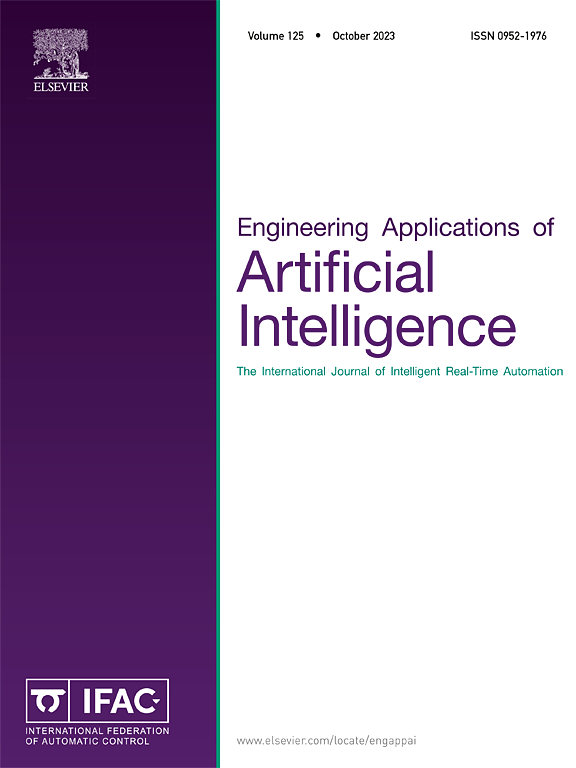PDFusion:一种基于物理数据融合的领域自适应增量学习模型,用于锂离子电池状态估计
IF 7.5
2区 计算机科学
Q1 AUTOMATION & CONTROL SYSTEMS
Engineering Applications of Artificial Intelligence
Pub Date : 2025-05-02
DOI:10.1016/j.engappai.2025.110913
引用次数: 0
摘要
电池状态的准确估计是保证锂离子电池安全、稳定、高效运行的关键。充电状态(SOC)和能量状态(SOE)是评估电池健康状况的关键参数,但由于复杂电池充放电过程的非线性、非平稳和强耦合特性,准确估计它们仍然具有挑战性。为了解决这些问题,提出了一种新的由物理和数据驱动的领域自适应增量学习模型。为了降低状态噪声和协方差,提出了一种新的卡尔曼滤波方法进行初级趋势预测。然而,基于物理的模型无法估计包含时频模式的季节成分。为了克服这一局限性,提出了一种基于时频交互注意(TIA)的数据驱动模型,以准确捕捉时间关系并有效补偿峰值误差。为了使模型在不同的温度条件下运行,采用了域自适应增量学习策略。在磷酸铁锂(LFP)和镍钴锰(NCM)电池上的结果表明,所提出的模型优于当前最先进的(SOTAs),在两种操作条件下,LFP的平均均方根误差(RMSE)和平均绝对误差(MAE)分别为0.048和0.021,NCM的平均均方根误差为0.060和0.023。在北京动态应力测试(BJDST)条件下,RMSE和MAE分别降低了22.69%和28.56%。在US06高速公路驾驶计划(US06)条件下,这些指标分别减少了41.02%和49.09%。该算法对温度具有很高的鲁棒性,能够精确估计锂离子电池的状态。本文章由计算机程序翻译,如有差异,请以英文原文为准。

PDFusion: A domain-adaptive incremental learning model based on Physical-Data Fusion for lithium-ion battery state estimation
Accurate estimation of battery state is crucial for ensuring the safe, stable, and efficient operation of lithium-ion batteries. State of Charge (SOC) and State of Energy (SOE) are critical parameters for assessing battery health, but accurately estimating them remains challenging due to the nonlinear, non-stationary and strong coupling characteristics of complex battery charging and discharging processes. To address these issues, a novel domain-adaptive incremental learning model driven by both physical and data is proposed. To reduce state noise and covariance, a novel Kalman Filtering method is used for primary trend prediction. However, physics-based models fail to estimate the seasonal components that contain time-frequency patterns. To overcome the limitation, a data-driven model with Time-frequency Interactive Attention (TIA) is proposed to accurately capture the temporal relationships and effectively compensate for peak errors. To make the model operate across different temperature conditions, a domain-adaptive incremental learning strategy is employed. The results on Lithium iron phosphate (LFP) and Nickel Cobalt Manganese (NCM) batteries show that the proposed model outperforms current state-of-the-art (SOTAs), with the average Root Mean Square Error (RMSE) and Mean Absolute Error (MAE) of 0.048 and 0.021 for LFP under two operating conditions, and 0.060 and 0.023 for NCM. Under Beijing Dynamic Stress test (BJDST) conditions, RMSE and MAE are reduced by 22.69% and 28.56% respectively. Under US06 Highway Driving Schedule (US06) conditions, these metrics are reduced by 41.02% and 49.09%, respectively. The algorithm exhibits high robustness to temperature, enabling precise estimation of the lithium-ion battery states.
求助全文
通过发布文献求助,成功后即可免费获取论文全文。
去求助
来源期刊

Engineering Applications of Artificial Intelligence
工程技术-工程:电子与电气
CiteScore
9.60
自引率
10.00%
发文量
505
审稿时长
68 days
期刊介绍:
Artificial Intelligence (AI) is pivotal in driving the fourth industrial revolution, witnessing remarkable advancements across various machine learning methodologies. AI techniques have become indispensable tools for practicing engineers, enabling them to tackle previously insurmountable challenges. Engineering Applications of Artificial Intelligence serves as a global platform for the swift dissemination of research elucidating the practical application of AI methods across all engineering disciplines. Submitted papers are expected to present novel aspects of AI utilized in real-world engineering applications, validated using publicly available datasets to ensure the replicability of research outcomes. Join us in exploring the transformative potential of AI in engineering.
 求助内容:
求助内容: 应助结果提醒方式:
应助结果提醒方式:


